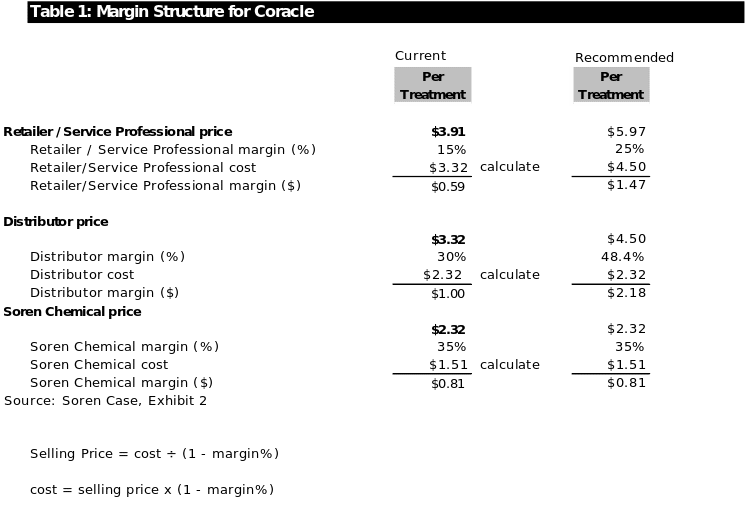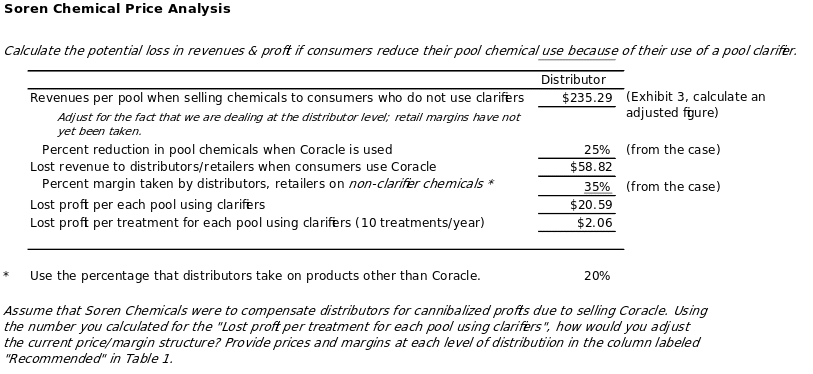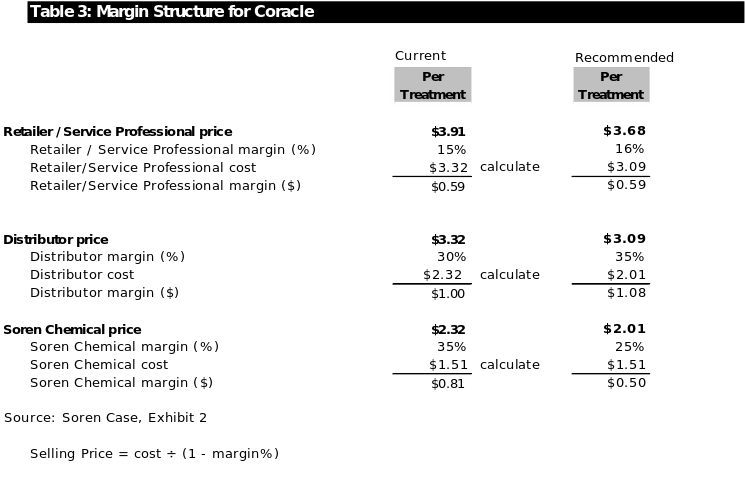Introduction to the problem
Soren Chemical is the company that produces Coracle, targeting the residential pools segment. Jen Moritz is the marketing manager in the Water Treatment Products department. She is responsible for the sales target set for Coracle. Jen Moritz major problem is to increase the sales to exceed the target.
In order to solve the problem, she will need to solve the problem of distributors and lower the product’s price. She needs to improve on user-awareness, by using a more effective channel of marketing.
Estimation of the market potential and Coracle’s market share
- Retail market size = (average annual cost of Clarifiers) x (number of residential pools) x (percentage of pool owners who understand and use Clarifiers)
Retail market size = $50 x 9,000,000 x 25% = $112,500,000 - Manufacturer market size = (retail market size) x (manufacturer prices as a percentage of retail prices)
Manufacturer market size = $112,500,000 x ((14.88/25) x100%)
= $112,500,000 x 0.5952 = $66,960,000 - Coracle’s share of the manufacturer market = ($1.5 million projected revenues) / (manufacturer market size)
Coracle’s share of the manufacturer market = $1,500,000 / $66,960,000 = 0.02240143
0.02240143 is approximately 2.24%
Current problems and potential growth of revenues
The first-year revenue goal for Coracle is $1.5 million. It is reasonable because it is a small percentage of the manufacturers’ market. Coracle’s share of the market is 2.24%. The brand has put a lower target compared with the market potential.
At $112.5 million, the retail market size for residential flocculants indicates that there is a very high potential for the growth of revenues. If the firm manages to build Coracle as a successful brand, it has a high potential to increase its revenues.
Coracle presents 3.7 times the potential for revenues provided by Kailan MW ($112.5 million divided by $30 million).
Internal situation analysis: market mix
The product
Coracle is applied fewer number of times in the same period as competitors’ products, which means less need for storage and less costs. Coracle is more effective than most of the competitors’ products in the flocculants segment. It helps swimming pool owners save 20% to 30% of the total chemical costs compared with competitors’ products.
Promotion
Currently, the product’s promotion targets specialty retailers and pool service professionals. The brand uses brochures, posts in publications, technical notes, and the Website for marketing.
The promotion does not directly target pool owners. Pool owners would be attracted when they note that it saves them 20% to 30% of the total chemical costs. It also reduces the number of applications per month compared with competitors’ products.
All its promotion uses the written media. It limits its target population to those who enjoy reading publications and those who can visit its Web site. The firm should consider an audio-visual advertisement on a television channel to reach most of the pool owners. It can also use radio advertisement.
The budget may be considered adequate if the brand continues with its current media channel for promotion. However, if it decides to advertise in a popular national channel, the budget is able to run an advertisement a few times.
The promotion budget is inadequate if the brand wants to run an effective advertisement in a popular media channel.
Price/ Distribution
The pros and cons of Coracle’s selling price and margin to distributors
The main advantage to distributors of the current Coracle prices is that they earn a higher margin than other products, 30% compared with 20%. Another advantage is that Coracle offers a large opportunity for growth because the residential market is 3.7 times the size of the commercial market.
Eventually, their earnings would increase if they promote Coracle.
The main disadvantage is that Coracle’s price per treatment is the highest in the residential pool segment. It is higher than ClearBlu, which is considered the most effective product.
Distributors are interested in selling Coracle under their own private labels because they want to build their own brands. It increases manufacturers’ reliance on them. It may increase sales for specific distributors without promoting all distributors.
Distributors may hesitate to carry and sell Coracle because it threatens their revenues in other pool chemicals.
The pros and cons of Coracle’s selling price to pool owners
The main advantage to pool owners is that Coracle reduces the cost of other chemicals by 20% to 30%. When that is taken into account, Oracle is cheaper per treatment than competitors’ products.
The main disadvantage is that Coracle’s price per treatment is the highest in the residential pool segment.
Changing the price structure to suit distributors
Table 1: Margin structure

Table 2: Soren Chemical price analysis

Table 1, shown above, indicates that the price of Coracle would be $5.97 when the distributors and retailers are compensated for the loss of opportunity in selling other chemicals.
The retailers’ price ($5.97) is obtained by adding $2.06 to $3.91, which is the current retail price. Other chemicals are reduced by 25% when Coracle is used (25% is the average between 20% and 30%).
Out of the $2.06 loss of profit, distributors lose to retailers lose by a ratio of 4:3, which is derived from the percentages of their margin (20%: 15%). Using the ratio of how the loss of profit is distributed, it can be obtained that the distributors will lose $1.18 per treatment.
The retailers will lose $0.88 per treatment. The calculations are done from the bottom upwards (see Table 1).
The price of Coracle at the Soren Chemical’s price level remains the same. In the distributors’ margin, $1.18 is added to $1.00 to obtain $2.18. It facilitates the calculation of the distributors’ margin as a percentage of distributors’ price.
Distributors’ price is obtained by adding the margin ($2.18) to Soren Chemical’s price ($2.32). One obtains $4.50. The distributors’ percentage margin is obtained by dividing $2.18 by $4.50. One obtains 48.4%.
The retailers’ margin also starts by adding $0.88 to the current margin of $0.59 to obtain $1.47. The retailers’ price is calculated by adding $1.47 to the distributors’ price ($4.50) to obtain $5.97. The percentage is calculated by dividing the retailers’ margin by the retailers’ price ($1.47/ $5.97 = 24.6%).
In the above calculations, Soren Chemicals will be able to eliminate the resistance by distributors to carry and sell Coracle. It will also solve retailers’ potential loss of opportunities in the sale of other chemicals.
Recommendation
Resolving the distributor/ retailer problem by adding the lost profit onto the price of Coracle is not feasible, considering that Coracle has the highest price per treatment in the segment. Pool owners will be unlikely to purchase a product that is about twice the price of competitors’ products.
Another alternative, Soren Chemical should reduce its margin to 25%. It should increase that of distributors to 35% and retailers to 16%. The price of Coracle will be $3.68 (see Table 3 below). It would make Coracle to have a lower price than ClearBlu ($3.75).

It will solve the price problem, but it will not solve the distributor problem. Distributors may be convinced of the market potential when residential pools segmented in fully tapped.